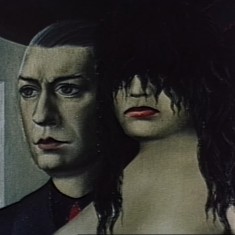The Happiness of Bein Loved
A presentation of the surrealist world of Félix Labisse. Henri Storck, as in his films on Paul Delvaux, takes the paintings out of their frame and invites us into an animated world, fictionalised by his camera.
Here too, woman is the central subject but this time confronted with animal or vegetable metaphors, fantasies of blood or witchcraft. Many good poets and famous friends are called upon to help out in terms of drama or sound. This film does not have the magic and enchanting unity of Le Monde de Paul Delvaux, but it must be remembered that Jean Dypréau used to say of this artist that he was the person who had given painting the most bruises. The very subject of the film disheartens him and yet, in an art film the artist must be the equal of the filmmaker. When one weakens the other is betrayed, whatever ties of friendship bind them.
Direction and argument : Henri Storck
Text : Pierre Seghers (including quotations from William Blake, Guillaume Apollinaire, Federico Garcia Lorca, Lise Deharme)
Poem by Paul Eluard recited by Catherine Lecouey
Camera : José Dutillieu, Georges Strouvé, Marcel Weiss
Editing : Henri Storck
Music : Philippe Arthuys; Cantilena d’Hector Villa-Lobos sung by Maria d’Apparecida
Voice : Jean Desailly and Félix Labisse
Sound editing : Sylvie Blanc
Co-production : André Tadié (Paris), Henri Storck (Brussels)
Featuring the friends of the artist : Maria d’Apparecida, Claude Bessy, Lise Deharme, Jean-Louis Barrault, César, Maurice Henry, Claude Hersaint, Pierre Seghers, Bill Copley, Jacques Hérold, Eurgène Ionesco, Pierre Prévert, Patrick Waldberg
Dutch version entitled Van het geluk bemind te zijn, text by Karel Jonckheere. German version entitled Das Glück geliebt zu sein.
35mm/colour (Eastmancolor)/14’/1962
To wach the film please send an email to info@fondshenristorck.be, ask the password and click here
Le bonheur d’être aimé, Les malheurs de la guerre… They are so beautiful and so well made that stating reservations on a few minor points in the text would be to quibble, it would be small-minded. If the first, slightly longer, seems to be the most convincing, it is doubtless because it is more central to the artist’s work, or his main aim: women depicted by a surrealist; but also because of the perfection of the set up, image by image structured in the manner of a tale (the construction or the script is by the director). When all is said and done Labisse is lucky. What better way to present his provocative and skilful work?
Jean Queval, Henri Storck ou la traversée du cinéma, Belgian Festival, November 1976



